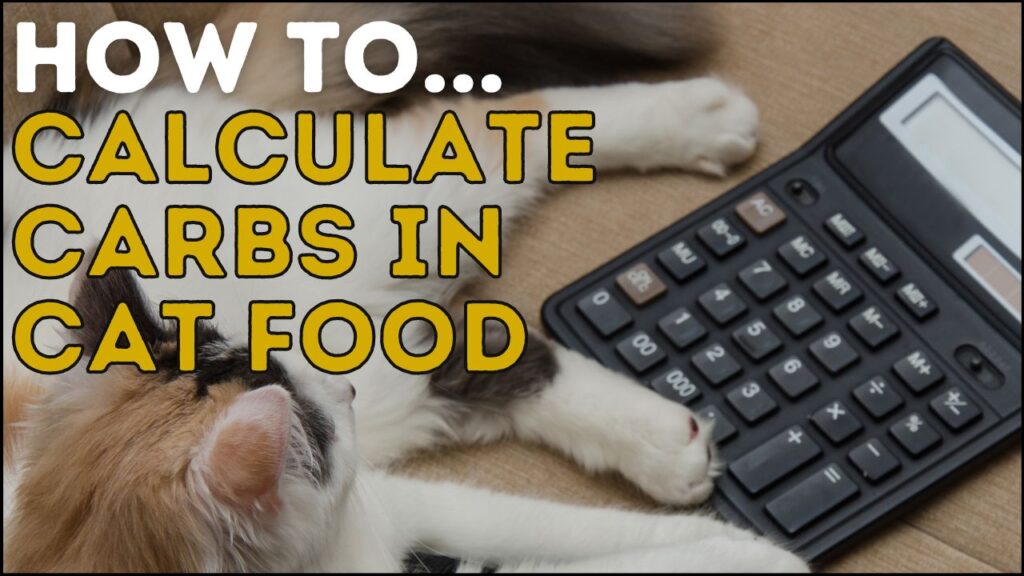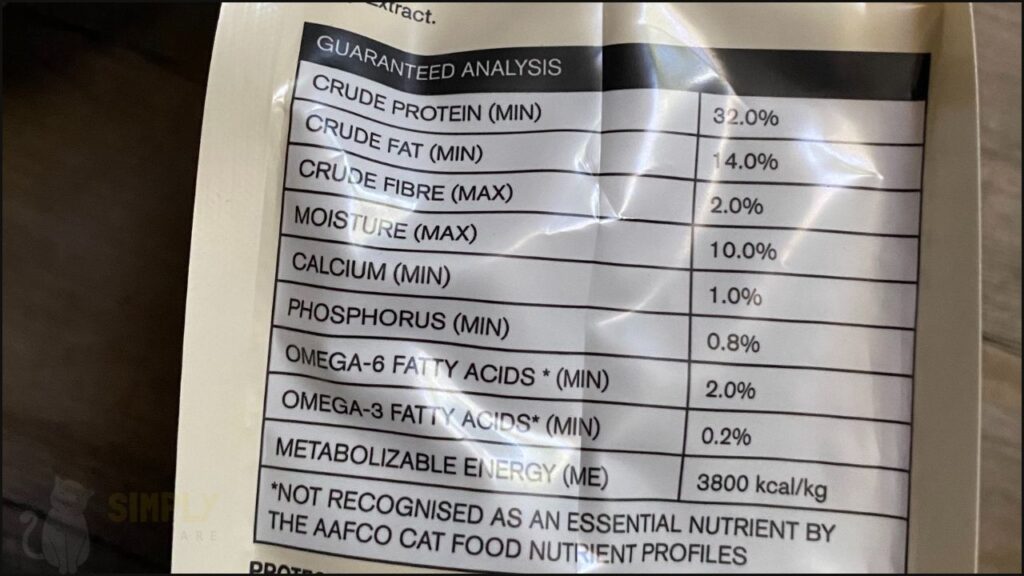Cats are obligate carnivores.
They have zero need for carbohydrate. For top health, you want to look for cat food with a low carb content.
The problem?
Most cat foods don’t include any information on carbs. Sneaky!
But given it’s importance to health, it’s a good idea to calculate it.
How?
In this article, find out how to calculate carbs in cat food and what to aim for. I’ll also go through frequently asked questions on the topic.
I recommend seeking the advice of a vet for any further questions. The advice in this article is not intended as medical advice.
Let’s go.

How to Calculate Carbs in Cat Food
You can do this manually or with a dry matter calculator.
Here’s how to do it yourself:
How to Calculate Carbs
Find the guaranteed analysis on the cat food.
This is on the back or sides of the cat food.

We’re interested in the following:
- Crude protein
- Crude fat
- Crude fiber
- Moisture
- Ash
All the nutrients add to 100%.
Add everything and subtract from 100%. That gets you the carb content.
Uh oh, there’s a problem though. Where’s the ash?
Many brands don’t include the ash. In general, by default it’s around 2% for wet cat food, and 6% for dry cat food.
Assuming that, we’ve got:
- Crude protein: 32%
- Crude fat: 14%
- Crude fiber: 2%
- Moisture: 10%
- Ash: 6% (estimated)
Add it up:
32 + 14 + 2 + 10 + 6 = 64%
To get carbs it’s 100 – 64 = 36%.
So 36% carbs.
This is on an as fed basis. What you want to do is convert to a dry matter basis. That way, you can compare to wet cat food (which has high moisture content).
To do that, subtract moisture from 100 (dry matter basis).
In this case:
100 – 10% (moisture) = 90%
In other words, there’s 90% dry matter.
Here’s the calculation to find dry matter carbohydrate (or any other nutrient):
(% carb / % dry matter) x 100 = % dry matter basis nutrient
So:
(36/90) x 100 = 40%
That means we’ve got 40% carbs on a dry matter basis.
Another option is to use an online calculator. This makes it easier for some.
How Many Carbs Should a Cat Have per Day?
Aim for a diet with less than 12% carbs on a dry matter basis (or as close to this as possible).
This is based on a cats preference.
In the wild, cats eat a very low carb diet (1-2%). There’s no need for carbs.
What if your cat gets too much?
In the short term, eating too many carbs may lead to diarrhea.
High carb diets also affect long term health.
It depends on the overall diet and calorie intake too. Unfortunately, dry food is highest in carbs and gets over served due to free-feeding.
Learn More:
Frequently Asked Questions
Does Dry Cat Food Have More Carbs Than Wet?
Yes.
On average, dry food has double the carbs of wet.
The average dry cat food is 20% carbs compared to 10% for wet. Limit dry food in your cats diet.
Does Wet Cat Food Have Carbs?
Sometimes.
On average, wet food has 10% carbs. Some less, and some more.
Fillers like tapioca starch and flour are thickeners for gravy. Some brands add rice and other grains.
Is Fancy Feast High in Carbs?
Yes and no.
Their wet cat food is very low in carbs in my experience. However, their dry cat food range is very high.
Learn More:
How Do You Calculate Total Grams of Carbs?
Use the dry matter carbs.
For example, let’s say it’s 40%.
The look for the calorie content. Example below:

Find metabolizable energy (ME).
It’s 3,800 kcal/kg.
40% of 3,800 is 1,520 kcal.
There’s 4 kcal of carbs for every gram of carbohydrate.
So to find grams:
kcal carb per kg / 4 = grams carb per kg
1,520 / 4 = 380g carb per kg
Alright, so to know the grams of carbs per serve, find out how much you’re serving your cat.
Let’s say you serve 50g of cat food. Since there’s 380g of carbs per kg, you’ll need to do the following:
grams carb per kg / serving in kg = grams carbs per serve
So:
380 / 0.05 = 19g of carbohydrate
Conclusion
Calculating carbs is important to find out the quality of the cat food.
Cat food labels and ingredient lists have misleading information. Calculating the nutrients helps you find out the quality of what you’re buying.
To make it easier, use a dry matter carbohydrate calculator. For your cats health, aim for less that 12% carbs on a dry matter basis.
